I’ve had precious little time in the B777 over the past 12 months, and to be honest I don’t anticipate flying one again. But I came across some content that I created early last year and thought one last article for old time’s sake. We introduced a Fuel Leak into the last recurrent phase towards the end of 2019 – the following is some of the learning that came from that exercise.
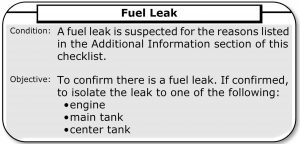
Procedures & Techniques : Fuel Leak
The Fuel Leak checklist is one of the more complex checklists in the B777 library. In principle – the standard rules apply.
- Take each line as it comes.
- Read it carefully.
- Have a clear idea of the outcome you expect from the checklist.
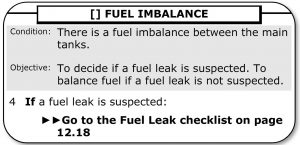
As always there is a balance to be achieved between a rote reading and execution of the checklist items; against an understanding of what the checklist does and what it’s trying to achieve.
One possible complication is entering the Fuel Leak checklist from the FUEL IMBALANCE checklist. If this is the case – when Fuel Leak … Checklist Complete – it’s possible to be returned by the ECL to the FUEL IMBALANCE checklist to continue with “Resume Normal Fuel Management” … or not.
Fuel Leak Checklist
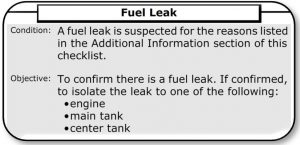 The Fuel Leak checklist steps through the following sequences.
The Fuel Leak checklist steps through the following sequences.
- Establish the need for diversion and configure the fuel system for a possible leak.
- Identify whether the leak is either, an Engine/Main Tank or Center Tank leak
- An Engine/Main Tank Leak will result in an Engine Shutdown. Which could then be restarted if the leak is subsequently determined to be a Main Tank leak.
- A Center Tank Leak leads to using the remaining Center Tank fuel; and ensuring sufficient fuel remains in the Main Tanks for completion of the flight.
 If the leak is neither Engine/Main Tank nor Center Tank (therefore … no leak) – Resume Normal Fuel Management … such as Fuel Balancing.
If the leak is neither Engine/Main Tank nor Center Tank (therefore … no leak) – Resume Normal Fuel Management … such as Fuel Balancing.
Sounds simple, right?
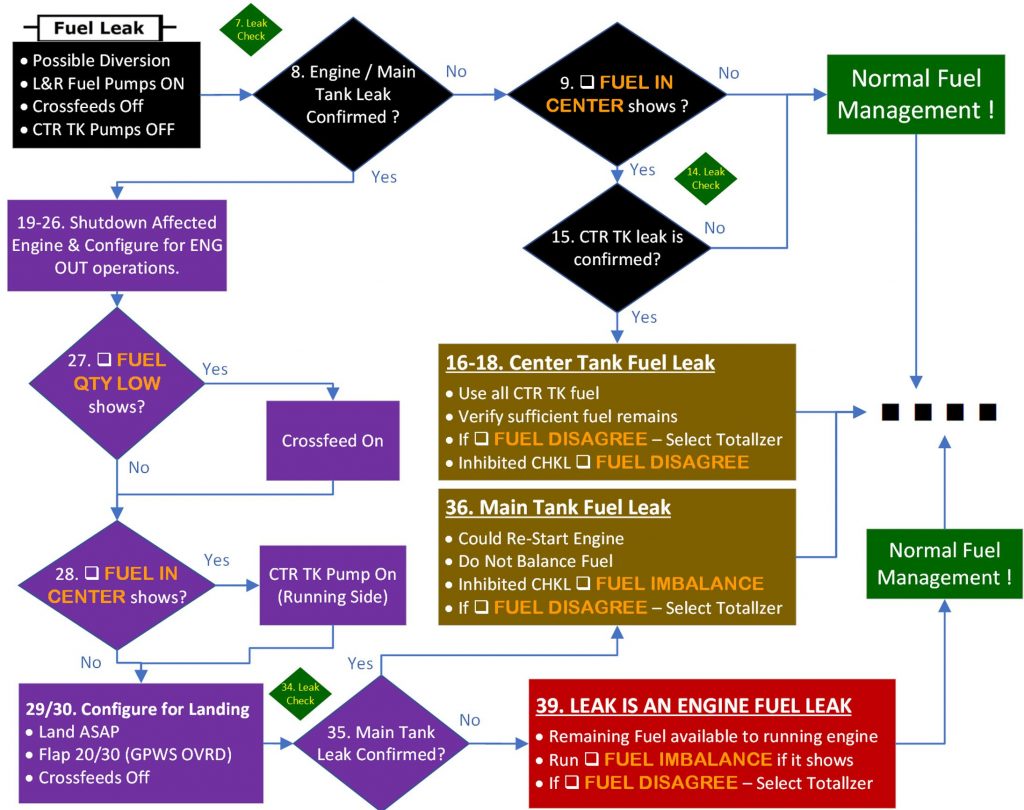
Checking For A Leak
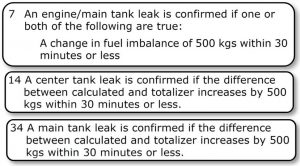 The Fuel Leak checklist prompts crew to check for a leak (or the stopping of a leak) at several points.
The Fuel Leak checklist prompts crew to check for a leak (or the stopping of a leak) at several points.
- Step 7 : Initially check for a Main Tank/Engine leak by measuring an increase in Fuel Imbalance by 500kg or more in 30 minutes or less.
- Step 14 : Check for a Center Tank fuel leak by measuring an increase in the discrepancy between Calculated/Totalizer of 500kg in 30 mins or less.
- Step 34 : Check for a Main Tank fuel leak by measuring an increase in the Discrepancy between Calculated/Totalizer Fuel in 30 mins or less.
One trap is to be careful when the checklist asks you to measure the increase in Discrepancy (Totalizer/Calculated) vs Fuel Imbalance. Don’t confuse the two.
One suggestion has been to note down the FQIS Left/Right/Center/Total indications (along with the CDU Totalizer/Calculated values) and the time when you start the checklist. This is not a bad idea – but note that if you change configuration (or shut and engine down) then you need to start again with a new set of initial values and start time.
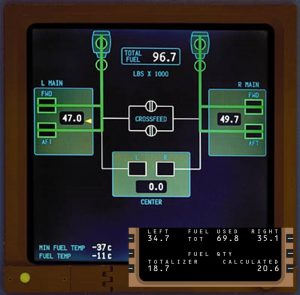 Finally – the checklist requires you to see a 500kg in 30 minutes or less. In principle this requires you to wait for either 500 kg or 30 minutes. But it seems reasonable to take a measure along the way and should the trend indicate compliance with the requirement – to continue with the checklist. So if after 10 minutes you have a 300kg change (or Zero) it seems reasonable to continue the checklist on the basis of having identified an ongoing leak (or that there is no leak). If you’re going to do this (and I’m not encouraging you to) beware of rounding issues in indication and agree across the flight deck that the trend you are assessing will clearly meet (or ideally exceed) the identifying requirement. Even if you continue the checklist – keep monitoring the trend to the 500 kg / 30 minute requirement to ensure compliance. This tends to be something that’s done in the sim where time is a pressure factor and your instructor seems eager for you to move through the checklist …
Finally – the checklist requires you to see a 500kg in 30 minutes or less. In principle this requires you to wait for either 500 kg or 30 minutes. But it seems reasonable to take a measure along the way and should the trend indicate compliance with the requirement – to continue with the checklist. So if after 10 minutes you have a 300kg change (or Zero) it seems reasonable to continue the checklist on the basis of having identified an ongoing leak (or that there is no leak). If you’re going to do this (and I’m not encouraging you to) beware of rounding issues in indication and agree across the flight deck that the trend you are assessing will clearly meet (or ideally exceed) the identifying requirement. Even if you continue the checklist – keep monitoring the trend to the 500 kg / 30 minute requirement to ensure compliance. This tends to be something that’s done in the sim where time is a pressure factor and your instructor seems eager for you to move through the checklist …
If you find my content useful and are in a position to do so – I would appreciate a contribution to my PayPal account (ken.pascoe@gmail.com) – If you use the Friends and Family feature in PayPal it reduces the charges to the transfer.
Regards, Ken Pascoe
